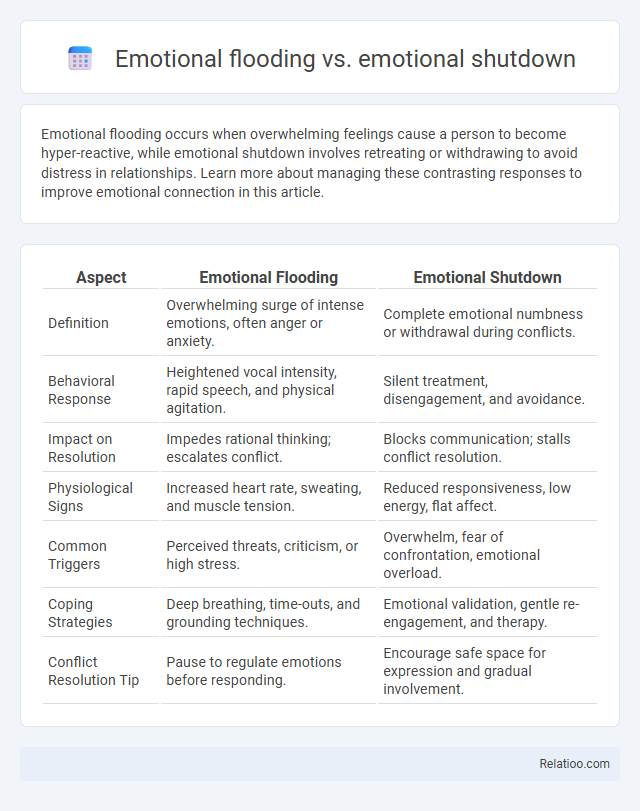Emotional flooding occurs when overwhelming feelings cause a person to become hyper-reactive, while emotional shutdown involves retreating or withdrawing to avoid distress in relationships. Learn more about managing these contrasting responses to improve emotional connection in this article.
Table of Comparison
| Aspect | Emotional Flooding | Emotional Shutdown |
|---|---|---|
| Definition | Overwhelming surge of intense emotions, often anger or anxiety. | Complete emotional numbness or withdrawal during conflicts. |
| Behavioral Response | Heightened vocal intensity, rapid speech, and physical agitation. | Silent treatment, disengagement, and avoidance. |
| Impact on Resolution | Impedes rational thinking; escalates conflict. | Blocks communication; stalls conflict resolution. |
| Physiological Signs | Increased heart rate, sweating, and muscle tension. | Reduced responsiveness, low energy, flat affect. |
| Common Triggers | Perceived threats, criticism, or high stress. | Overwhelm, fear of confrontation, emotional overload. |
| Coping Strategies | Deep breathing, time-outs, and grounding techniques. | Emotional validation, gentle re-engagement, and therapy. |
| Conflict Resolution Tip | Pause to regulate emotions before responding. | Encourage safe space for expression and gradual involvement. |
Understanding Emotional Flooding
Emotional flooding occurs when Your body is overwhelmed by intense emotions, triggering a fight-or-flight response that disrupts rational thinking and communication. Unlike emotional shutdown, where feelings are suppressed and disconnection occurs, emotional flooding involves an overload of emotional stimuli that can escalate conflicts and impair decision-making. Understanding emotional flooding enables better management of stress reactions, improving emotional regulation and interpersonal relationships.
Defining Emotional Shutdown
Emotional shutdown occurs when your brain blocks overwhelming feelings, resulting in numbness, disconnection, and inability to process emotions effectively. Unlike emotional flooding, which involves intense and uncontrollable emotions, shutdown is a protective response that halts emotional awareness to avoid distress. Recognizing emotional shutdown is crucial for improving emotional regulation and mental well-being.
Key Differences Between Flooding and Shutdown
Emotional flooding refers to an overwhelming surge of intense feelings that inundate an individual's capacity to process emotions, causing heightened physiological arousal and often impulsive reactions. Emotional shutdown, in contrast, involves a protective withdrawal where emotional responses are dampened or suppressed, leading to numbness or disconnection from feelings. The key differences between flooding and shutdown lie in their physiological and behavioral manifestations: flooding triggers hyperactivation and reactive behaviors, while shutdown results in hypoactivation and emotional disengagement.
Causes and Triggers of Emotional Flooding
Emotional flooding occurs when overwhelming emotions, such as intense anger or fear, trigger a fight-or-flight response, often caused by perceived threats or high stress situations. Emotional shutdown happens as a protective mechanism where the brain suppresses feelings to avoid further psychological pain, typically triggered by trauma or prolonged emotional distress. Unlike emotional flooding, which is marked by excessive emotional arousal, emotional shutdown results from a shutdown of emotional responses to cope with overwhelming triggers.
Common Triggers for Emotional Shutdown
Emotional flooding occurs when overwhelming feelings surge uncontrollably, while emotional shutdown involves numbing or shutting down to escape intense emotions. Common triggers for emotional shutdown include prolonged stress, fear of vulnerability, and experiences of trauma or abandonment. Understanding these triggers helps you recognize when your emotional defenses activate, allowing for healthier coping strategies.
Psychological and Physical Symptoms
Emotional flooding involves overwhelming psychological distress such as intense anxiety, confusion, and panic, accompanied by physical symptoms like rapid heartbeat, sweating, and shortness of breath. Emotional shutdown is characterized by psychological numbness, dissociation, and emotional detachment, often coupled with physical signs including decreased heart rate, muscle tension, and shallow breathing. Comparing the two, emotional flooding triggers hyperarousal in the nervous system, while emotional shutdown results in hypoarousal, reflecting distinct coping mechanisms in response to stress or trauma.
Impact on Relationships and Communication
Emotional flooding overwhelms your ability to process feelings, causing intense reactions that can disrupt communication and create distance in relationships. Emotional shutdown leads to withdrawal and avoidance, making it difficult for partners to connect or resolve conflicts effectively. Understanding these emotional responses helps improve empathy and fosters healthier interactions in your relationships.
Coping Strategies for Emotional Flooding
Coping strategies for emotional flooding include grounding techniques such as deep breathing, mindfulness, and progressive muscle relaxation to regain control and reduce physiological arousal. Expressive writing or verbalizing emotions in a safe environment helps process overwhelming feelings, preventing escalation into shutdown. Creating a supportive network and setting clear emotional boundaries can aid in recognizing triggers early and managing intense emotional responses effectively.
Coping Strategies for Emotional Shutdown
Emotional shutdown involves a withdrawal from emotional stimuli, often as a protective mechanism against overwhelming feelings, contrasting with emotional flooding where emotions become uncontrollably intense. Effective coping strategies for emotional shutdown include practicing mindfulness to reconnect with suppressed feelings, engaging in grounding techniques to stay present, and seeking therapeutic support to safely explore and express emotions. Building emotional awareness through journaling and gradual exposure to difficult emotions also facilitates recovery from shutdown states.
When to Seek Professional Help
Emotional flooding occurs when your intense feelings overwhelm your ability to process or respond, while emotional shutdown is characterized by numbing or withdrawing to avoid distress. Seek professional help if these emotional states disrupt daily functioning, cause persistent anxiety or depression, or lead to relationship conflicts. Early intervention with a mental health expert can provide coping strategies tailored to your emotional patterns and promote healing.

Infographic: Emotional flooding vs Emotional shutdown
 relatioo.com
relatioo.com